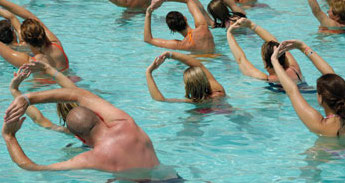Author – Dominic Gili – ePublication of Australian Fitness Network – Resources Library.

The splashing of water, the beat of the music, the endless chattering of participants. Not every sound in an aqua class is a welcome one, but by managing rather than eradicating talking in class, you can foster a healthy atmosphere for body and mind.
Humans are social animals. Social contact is instinctive to us, and it improves our mental wellbeing. So why do aqua fitness instructors get upset when participants talk in class? And can we manage our classes to not only improve participants’ physical wellbeing but also their mental health?
During a series of recent aqua instructor workshops presented across NSW, the most frequently asked question was ‘how can I stop people talking in class?’ The simple answer is ‘you will never stop people from talking in class’ – and neither should you, because the relaxed and friendly atmosphere of water workouts is part of what attracts people to this form of exercise in the first place.
Two independent studies (McGuire & Raleigh 1986, Gladstone et al 2007) have found that individuals with low social support appear to be more prone to mental illness than people with higher levels of support. For some participants, your aqua class fulfils an important social function; it is a social support network with physical and mental health benefits. Therefore, with the wellbeing of participants in mind, rather than seeking to silence the chatter completely, we should be asking ‘how can I best manage people talking in class?’
Left unmanaged, participants talking in class can impact negatively on the instructor by interrupting the teaching flow, and may also cause frustration among other class members intent on a more focused workout. Instructors must balance the needs of all participants and maintain harmony within the group to ensure that everyone gains from the experience and returns to future classes.
The following incident reinforces the importance of instructors demonstrating tolerance and sensitivity: one of my long-term class participants arrived late for class after being absent for a couple of months. She proceeded to chat continually with several participants throughout the warm up. After 10 minutes, without singling her out, I politely told the participants in her vicinity that it was time to stop talking and start working, and they complied. After class she approached me to apologise and explained that her husband had recently passed away.
Building rapport with clients from the very first introduction facilitates a path of communication in which you feel comfortable enough to address individuals in all matters, whether it be related to aquatic exercise or class etiquette. Setting boundaries for ‘talk time’ during warm-ups, cool-downs and partner work and ‘work time’ during other sections should help strike a manageable balance.
IDEAS FOR MANAGING PARTICIPANTS IN THE ‘TALK TIME’
- Announce at the end of the warm-up that it’s time to stop talking and start working hard
- Encourage talkers to move to the outskirts of the class space to reduce the impact on other participants
- Give participants the opportunity to move in different directions so that people situated near to talkers can move if they wish.
IDEAS FOR MANAGING PARTICIPANTS IN THE ‘WORK TIME’
- Work participants to their personal max and/or add suspended workouts
- Travel the group in different directions to shuffle people around
- Swap ends and teach your class from a different end of the pool (if possible) so participants need to face a different direction, thus turning one talker behind the other
- Ask the group or selected individuals a series of exercise-related questions
- Educate participants by sharing exercise tips, possible contraindications and exercise modifications
- Engage minds by adding choreography, coordinated, complex or counterintuitive moves
- Stand in front of the talkers when giving instructions
- If all else fails, remind them politely that it’s time to work and encourage them to join the group and yourself for coffee and a catch-up after class!
Some final strategies to manage chatter during ‘work time’ are routines in which participants work together in pairs or teams, e.g., forming conga lines or Zorba circles, or performing aquatic variations on dance routines such as the Nut Bush or Chorus Line.
Challenge yourself to design an aqua fitness class that will have your participants working so hard they beg for mercy and laughing so hard they double over in stitches. By demanding focus and hard work, while incorporating social time, you’ll leave participants exhausted but happy, and may even foster some out-of-class friendships.
